10 Best Ornamental Grasses for Shady Garden Spots
Finding the right ornamental grasses for shaded areas can transform your garden’s challenging spots into visual highlights. These top 10 shade-tolerant grasses offer texture, movement, and year-round interest while thriving in conditions where many plants struggle. From low-growing ground covers to taller accent specimens, these versatile grasses provide answers for various industry needs without demanding full sun exposure. Each variety brings unique characteristics in terms of foliage color, height, growth habit, and seasonal interest – giving you plenty of options to enhance your shady garden spaces with minimal maintenance requirements.
- Japanese Forest Grass (Hakonechloa macra) – This elegant grass forms graceful mounds of arching foliage that cascade like a waterfall. Growing 12-18 inches tall, it’s available in striking varieties including ‘Aureola’ with gold-striped leaves and ‘All Gold’ with bright chartreuse foliage. Japanese Forest Grass performs beautifully in dappled shade and moist, humus-rich soil.
- Northern Sea Oats (Chasmanthium latifolium) – Featuring distinctive flat seedheads that dangle from arching stems, Northern Sea Oats reaches 2-3 feet tall. The bamboo-like foliage turns a rich copper in fall, while the seedheads provide winter interest. This adaptable grass tolerates medium to full shade but may flop if grown in too much darkness.
- Tufted Hair Grass (Deschampsia cespitosa) – Creating airy plumes that rise 2-3 feet above neat foliage clumps, Tufted Hair Grass adds ethereal texture to shady spots. The delicate inflorescences catch light beautifully, creating a glowing effect when backlit. It thrives in partial shade and maintains good form even in challenging light conditions.
- Sedges (Carex species) – Technically not true grasses but grass-like in appearance, sedges offer many shade-tolerant options. Standouts include ‘Ice Dance’ with white-edged leaves, ‘Evergold’ with gold-striped foliage, and native Pennsylvania sedge for naturalistic plantings. Most sedges remain under 12 inches tall and spread slowly to form attractive groundcover.
- Hakone Grass (Hakonechloa macra ‘Beni-Kaze’) – This red-tinged cultivar offers spectacular fall color when its green summer foliage transforms to brilliant burgundy-red. Growing 12-18 inches tall and spreading to form neat clumps, ‘Beni-Kaze’ creates dramatic color contrast in shaded areas where autumn display options are often limited.
- Korean Feather Reed Grass (Calamagrostis brachytricha) – Producing feathery pink-tinged plumes in late summer, this 3-4 foot tall grass tolerates partial shade better than most reed grasses. The flower heads emerge with a distinctive pinkish-purple cast before fading to silver, creating months of visual interest in dappled light conditions.
- Ribbon Grass (Phalaris arundinacea var. picta) – With striking white-striped foliage, Ribbon Grass brightens shady corners, growing 2-3 feet tall. This vigorous grower thrives in partial shade and moist conditions, though its spreading habit requires thoughtful placement. The variegation appears most pronounced in areas with morning sun and afternoon shade.
- Palm Sedge (Carex muskingumensis) – Featuring unique palm-like leaf arrangements, this 2-foot tall sedge creates architectural interest in shaded locations. The bright green foliage forms upright clumps that maintain their structure throughout the growing season. Palm Sedge adapts well to moist, shady conditions while offering a distinctive texture unlike other shade plants.
- Black Mondo Grass (Ophiopogon planiscapus ‘Nigrescens’) – Though technically a lily family member, Black Mondo Grass provides dramatic nearly-black foliage in grasslike form. Growing 6-10 inches tall, it creates striking contrast against lighter plants and hardscape elements. Its dark color stands out beautifully in shaded settings where many plants tend to look washed out.
- Autumn Moor Grass (Sesleria autumnalis) – With fine-textured silvery-green foliage forming neat 12-inch clumps, Autumn Moor Grass tolerates partial shade while maintaining its compact form. The pale inflorescences appear in late summer, adding another dimension to this versatile grass that works well in contemporary and naturalistic garden designs alike.
Understanding Shade Requirements for Ornamental Grasses

Defining Different Types of Shade
Not all shade is created equal in your garden. Understanding the exact type of shade you’re dealing with helps select the right ornamental grasses for success. Full shade areas receive less than 3 hours of direct sunlight daily and remain mostly shadowed. Partial shade (or dappled shade) spots get 3-6 hours of filtered sunlight, often through tree canopies. Light shade receives morning sun but afternoon protection, providing 4-6 hours of indirect light. Deep shade, found under dense evergreens or north-facing walls, gets virtually no direct sunlight and presents the greatest challenge. Assess your garden throughout the day to identify how sunlight moves across your industry before selecting shade-tolerant grasses.
Why Some Grasses Thrive in Low-Light Conditions
Certain ornamental grasses have evolved exact adaptations that allow them to flourish where others would fail. These shade-tolerant varieties typically feature broader leaf surfaces to maximize light capture, efficiently converting minimal sunlight into energy through specialized chlorophyll arrangements. Many woodland-native grasses have developed slower growth rates that require less energy, focusing resources on survival rather than rapid expansion. Their root systems are often more efficient at nutrient extraction from typically acidic woodland soils. Also, these grasses have evolved enhanced disease resistance to combat the fungal issues common in damp, shaded environments. These adaptations make grasses like Japanese Forest Grass (Hakonechloa) and various sedges (Carex) particularly well-suited for shadier spots in your garden industry.
Japanese Forest Grass (Hakonechloa macra)
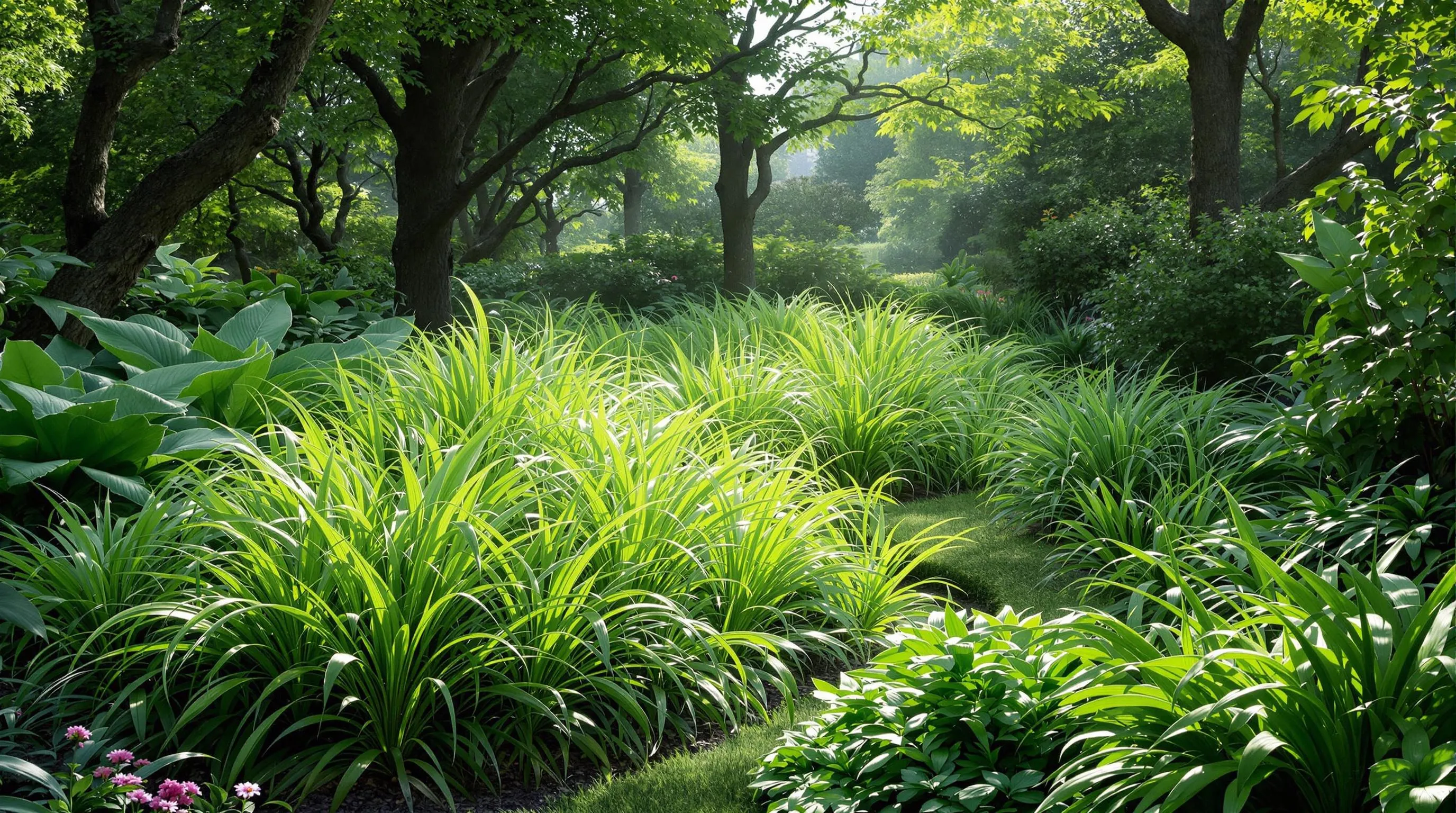
Japanese Forest Grass creates elegant, cascading mounds that bring movement and texture to shaded garden spots. This award-winning ornamental grass stands out with its arching habit and luminous foliage that seems to glow in dim light.
Growing and Care Requirements
Japanese Forest Grass thrives in partial to full shade, making it perfect for woodland gardens or north-facing locations. Plant it in rich, moist, well-draining soil with a pH between 5.5 and 6.5 for optimal growth. Water regularly during the first growing season to establish a strong root system, then maintain consistent moisture without waterlogging. Apply a layer of compost in spring to provide nutrients, followed by a light mulch to retain moisture and suppress weeds. Cut back old foliage in late winter or early spring before new growth emerges. This slow-growing grass reaches 12-18 inches tall and 18-24 inches wide, spreading gradually through rhizomes. It’s hardy in USDA zones 5-9 and generally pest-resistant, though slugs may occasionally become problematic in very damp conditions.
Design Ideas for Japanese Forest Grass
Use Japanese Forest Grass as a stunning ground cover beneath trees or large shrubs where its golden or variegated foliage can brighten dark corners. Plant it along woodland paths where its graceful movement catches attention from multiple angles. Create dramatic contrast by pairing it with broad-leaved hostas, ferns, or coral bells for textural interest. The ‘Aureola’ cultivar, with its bright gold-striped leaves, works beautifully against dark-leaved plants like heuchera or Japanese painted fern. For a serene water garden effect, position this grass near the edges of ponds or streams where its reflection doubles the visual impact. In container gardens, Japanese Forest Grass makes an excellent spiller component, softening edges with its waterfall-like growth habit. Its slow-growing nature also makes it ideal for Asian-inspired gardens where its bamboo-like appearance contributes to a meditative atmosphere.
Northern Sea Oats (Chasmanthium latifolium)
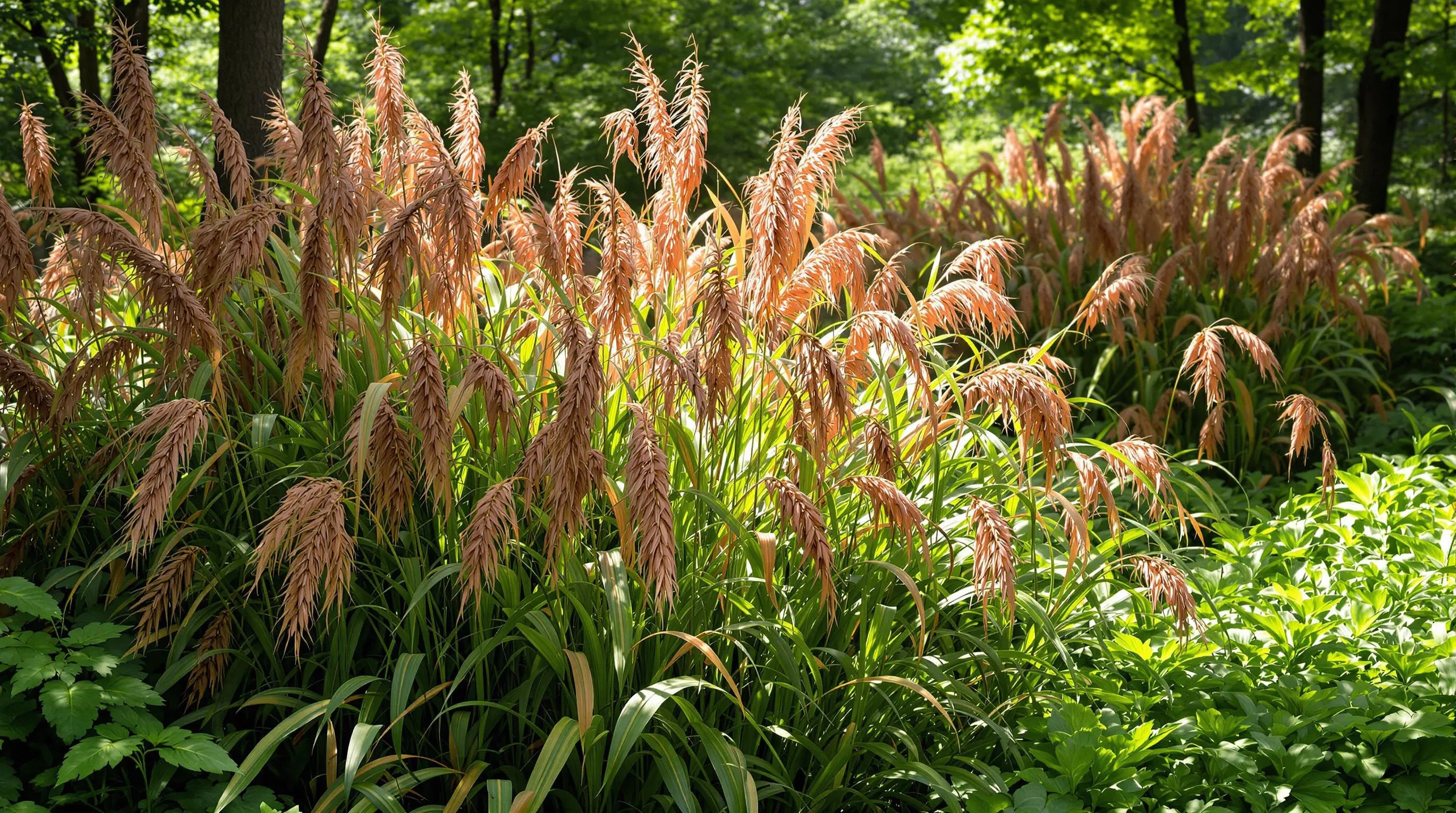
Northern Sea Oats brings dramatic movement and texture to shaded garden spaces with its distinctive bamboo-like foliage and dancing seedheads. This native North American grass reaches 2-3 feet tall and thrives in partial to full shade, making it a standout choice for woodland gardens or areas with dappled sunlight.
Cultivation Tips for Northern Sea Oats
Growing Northern Sea Oats successfully requires minimal effort once you understand its basic needs. Plant this adaptable grass in rich, moist soil with good drainage, spacing plants 18-24 inches apart to accommodate their arching habit. Water regularly during the first growing season to establish a strong root system, then reduce to occasional deep watering during dry spells. Northern Sea Oats tolerates clay soils and wet conditions better than many ornamental grasses, making it perfect for problem areas in your shade garden. For maintenance, simply cut back stems to 4-6 inches in late winter before new growth emerges. While this grass can self-seed vigorously in ideal conditions, removing seedheads before they mature helps control its spread if desired.
Seasonal Interest and Visual Appeal
Northern Sea Oats delivers year-round visual interest with its changing seasonal displays. In spring, fresh green foliage emerges with a slightly blue cast, creating a lush backdrop for early shade bloomers. By midsummer, the plant’s most distinctive feature appears—flat, dangling seedheads that resemble oats, starting bright green before transitioning to copper-bronze by fall. These seedheads create mesmerizing movement with the slightest breeze, catching light beautifully in dappled shade settings. Fall brings spectacular color as the foliage shifts to warm copper, gold and russet tones that persist well into winter. Even after frost, the dried seedheads remain intact, providing structure and texture through the dormant season. Pair Northern Sea Oats with shade-loving perennials like hostas, ferns, and heuchera for striking textural contrasts in your woodland garden design.
Sedges (Carex Species) for Deep Shade
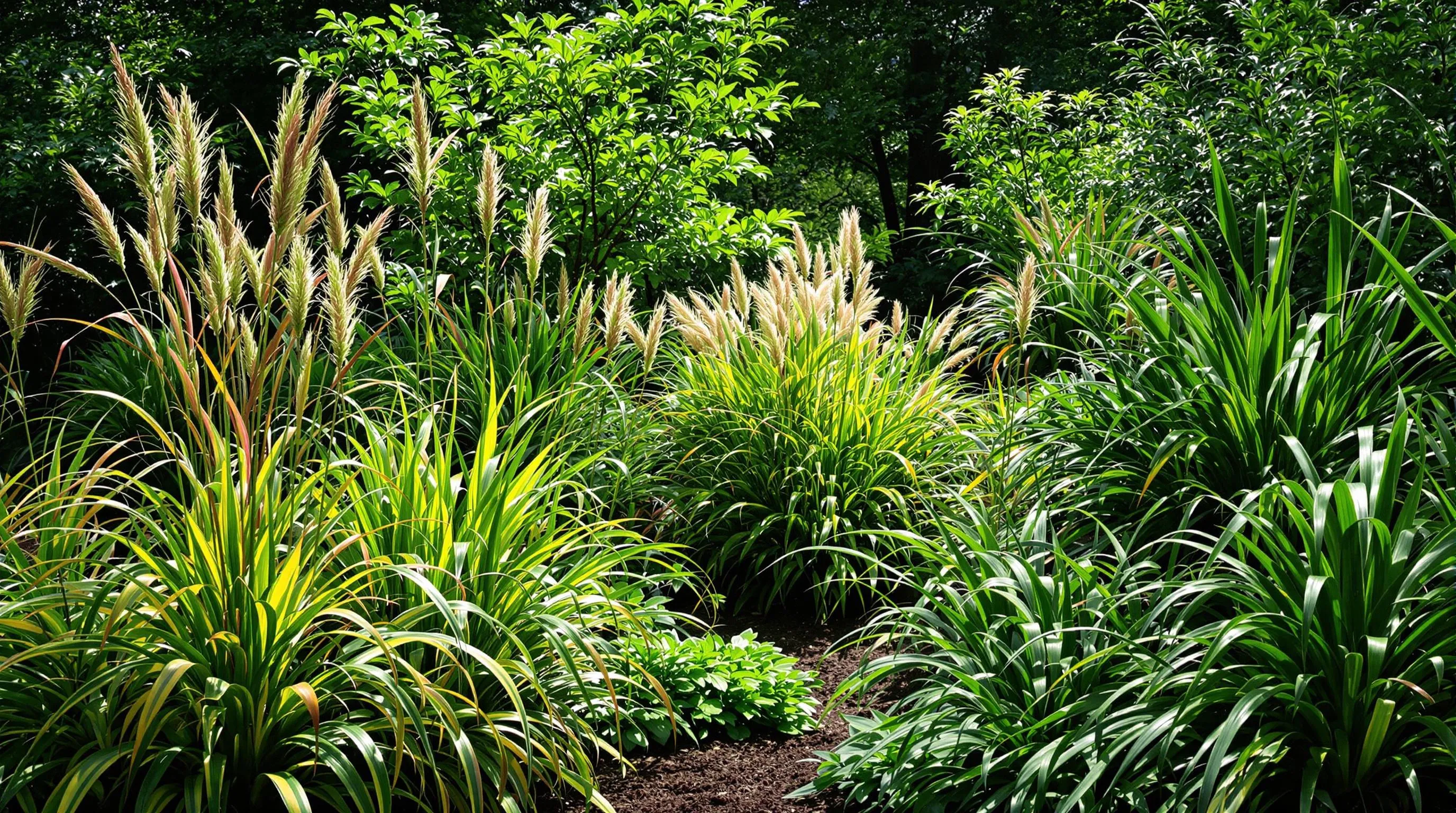
Sedges are the champions of deep shade gardens, thriving where most ornamental grasses struggle. These resilient plants belong to the Carex genus and feature grass-like appearances with triangular stems and adaptations that make them perfect for low-light conditions. With over 2,000 species worldwide, sedges offer remarkable versatility for challenging garden spots.
Gold-Edged Sedge (Carex oshimensis ‘Evergold’)
Gold-Edged Sedge creates a stunning focal point in deep shade with its distinctive variegated foliage. The leaves display a rich green center with bright gold edges that illuminate dark corners of your garden. Growing in neat, fountain-like clumps 12-18 inches tall, this evergreen sedge maintains its striking appearance year-round. ‘Evergold’ thrives in consistently moist soil but can tolerate short periods of drought once established. Plant this eye-catching sedge along woodland paths, in container gardens, or as a ground cover beneath trees where its golden highlights will create a beautiful contrast against darker surroundings. Unlike many ornamentals, ‘Evergold’ requires minimal maintenance—simply remove dead foliage in late winter before new growth emerges.
Pennsylvania Sedge (Carex pensylvanica)
Pennsylvania Sedge offers a native option for deep shade gardens with its fine-textured, soft green foliage that forms lush carpets 6-10 inches tall. This indigenous North American sedge spreads slowly via rhizomes, making it an excellent low-maintenance lawn alternative or woodland ground cover. Its delicate appearance belies remarkable durability—Pennsylvania Sedge tolerates dry shade conditions that challenge many other plants. In spring, subtle tan flower spikes add seasonal interest. This adaptable sedge grows best in well-draining, slightly acidic soil and requires minimal care once established. Plant it beneath trees, along shaded pathways, or as a transition between garden beds. Pennsylvania Sedge’s drought tolerance and erosion control capabilities make it particularly valuable for difficult slope plantings in shadier locations.
Ripple Grass (Acorus gramineus)

Ripple Grass, also known as Sweet Flag, is a versatile evergreen perennial that thrives in shade environments. This striking grass-like plant (technically a member of the Acoraceae family, not a true grass) features glossy, sword-shaped leaves that create elegant, rippling movements in the garden, making it a perfect addition to shaded areas needing textural interest.
Moisture Requirements and Growing Conditions
Ripple Grass loves consistently moist conditions and performs exceptionally well in partial to full shade. You’ll find it thrives in wet, boggy areas where many other ornamental grasses would struggle or fail. Plant Acorus gramineus in rich, organic soil with a pH between 5.5 and 7.0 for optimal growth. While this plant can tolerate standing water and even shallow pond margins, it doesn’t require these extreme conditions to flourish. Zones 5-9 provide the ideal climate for Ripple Grass, where it will maintain its attractive appearance year-round. Unlike many ornamental grasses, Ripple Grass doesn’t need to be cut back in winter, as its evergreen foliage continues to provide interest during colder months.
Using Ripple Grass in Shade Gardens
Incorporate Ripple Grass into your shade garden as a striking ground cover or edge planting, where its bright variegated varieties like ‘Ogon’ (golden) or ‘Variegatus’ (white-striped) illuminate dark corners. The compact size (typically 6-12 inches tall) makes it perfect for container gardens, woodland settings, and water garden margins. Plant it in groups of three or five for visual impact, or use it as a transition plant between larger shade perennials and hardscape elements. Ripple Grass pairs beautifully with hostas, ferns, and astilbes for a textural shade garden composition. Its aromatic leaves release a sweet, spicy fragrance when crushed, adding another sensory dimension to your garden experience. For low-maintenance shade gardens, combine Ripple Grass with Japanese Forest Grass and Black Mondo Grass for a striking trio that offers year-round interest with minimal care requirements.
Korean Feather Reed Grass (Calamagrostis brachytricha)
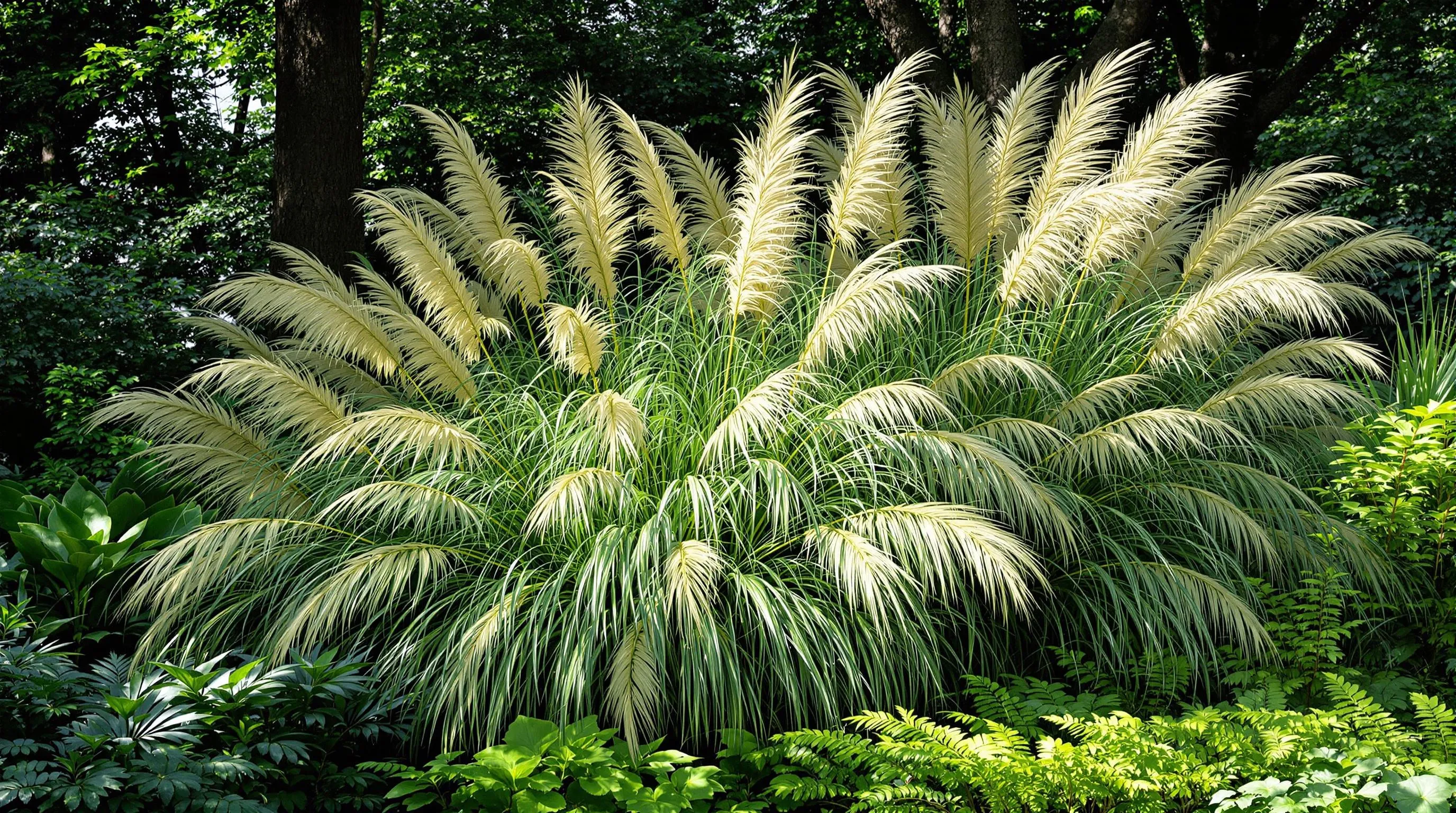
Korean Feather Reed Grass brings a touch of elegance to shaded landscapes with its stunning feathery plumes and graceful form. Unlike its sun-loving cousin Calamagrostis ‘Karl Foerster’, this Asian native thrives in partial shade conditions, making it a valuable addition to woodland gardens and shady borders.
Light Requirements and Growth Habits
Korean Feather Reed Grass performs best in partial shade to dappled sunlight, tolerating as little as 3-4 hours of direct sun daily. You’ll appreciate its adaptability to a variety of soil conditions, though it prefers consistently moist, well-draining soil with moderate fertility. This ornamental grass forms neat, upright clumps reaching 3-4 feet tall and 2-3 feet wide, creating a strong vertical accent in shade gardens. The foliage emerges as bright green blades in spring, providing a lush backdrop until late summer when stunning pink-tinged plumes appear, fading to silvery-tan as they mature. These feathery inflorescences persist well into winter, offering multi-season interest and catching morning light beautifully even in shaded locations.
Companion Plants for Korean Feather Reed Grass
Korean Feather Reed Grass pairs magnificently with shade-loving perennials that complement its vertical form and soft texture. Plant it alongside hostas, whose broad leaves create striking textural contrast with the grass’s fine blades. Ferns make excellent neighbors, sharing similar moisture requirements while adding delicate frond patterns. For seasonal color, combine with astilbes, whose fluffy plumes echo the grass’s inflorescences, or shade-tolerant hydrangeas whose broad flowers balance the grass’s verticality. In woodland settings, underplant with spring ephemerals like bleeding heart or hellebores for early-season interest before the grass reaches its peak. For dramatic foliage combinations, pair with heucheras whose colorful leaves brighten shady spots year-round and create a stunning base beneath the grass’s airy plumes.
Mondo Grass (Ophiopogon japonicus)

Mondo grass is a versatile evergreen perennial that thrives in shade gardens, creating elegant mounds of grass-like foliage that reach 6-12 inches tall. Even though its name, it’s actually a member of the lily family rather than a true grass. Its arching, strap-like leaves form dense, tufted clumps that spread slowly via underground rhizomes, making it perfect for shady spots where other plants struggle. Mondo grass tolerates a range of conditions from full shade to partial sun and adapts well to various soil types as long as drainage is adequate.
Dwarf Mondo Grass for Ground Cover
Dwarf mondo grass (Ophiopogon japonicus ‘Nanus’) offers a compact alternative to the standard variety, growing just 2-4 inches tall while maintaining the same elegant appearance. This miniature version creates a dense, weed-suppressing mat that’s ideal for shaded areas between stepping stones, under trees, or as a lawn substitute in difficult growing areas. It requires minimal maintenance once established and can handle light foot traffic. Plant dwarf mondo grass 4-6 inches apart for faster coverage, and you’ll enjoy its fine-textured appearance year-round. The slow-growing nature means less trimming and division compared to other ground covers, making it a truly low-maintenance option for shady areas.
Black Mondo Grass for Dramatic Effect
Black mondo grass (Ophiopogon planiscapus ‘Nigrescens’) delivers striking visual impact with its distinctive deep purple-black foliage that creates dramatic contrast in shade gardens. Growing 6-10 inches tall, this ornamental grass relative maintains its striking color year-round, even in deep shade conditions. Its dark blades provide the perfect backdrop for brightly colored plants or can stand alone as a bold accent. Plant black mondo grass alongside silver-leaved plants or pale flowers for maximum contrast, or use it to line shaded pathways for a sophisticated edge. Though slow-growing, its dramatic appearance and ability to thrive in challenging light conditions make it worth the wait for gardeners seeking distinctive texture and color in shaded landscapes.
Autumn Moor Grass (Sesleria autumnalis)
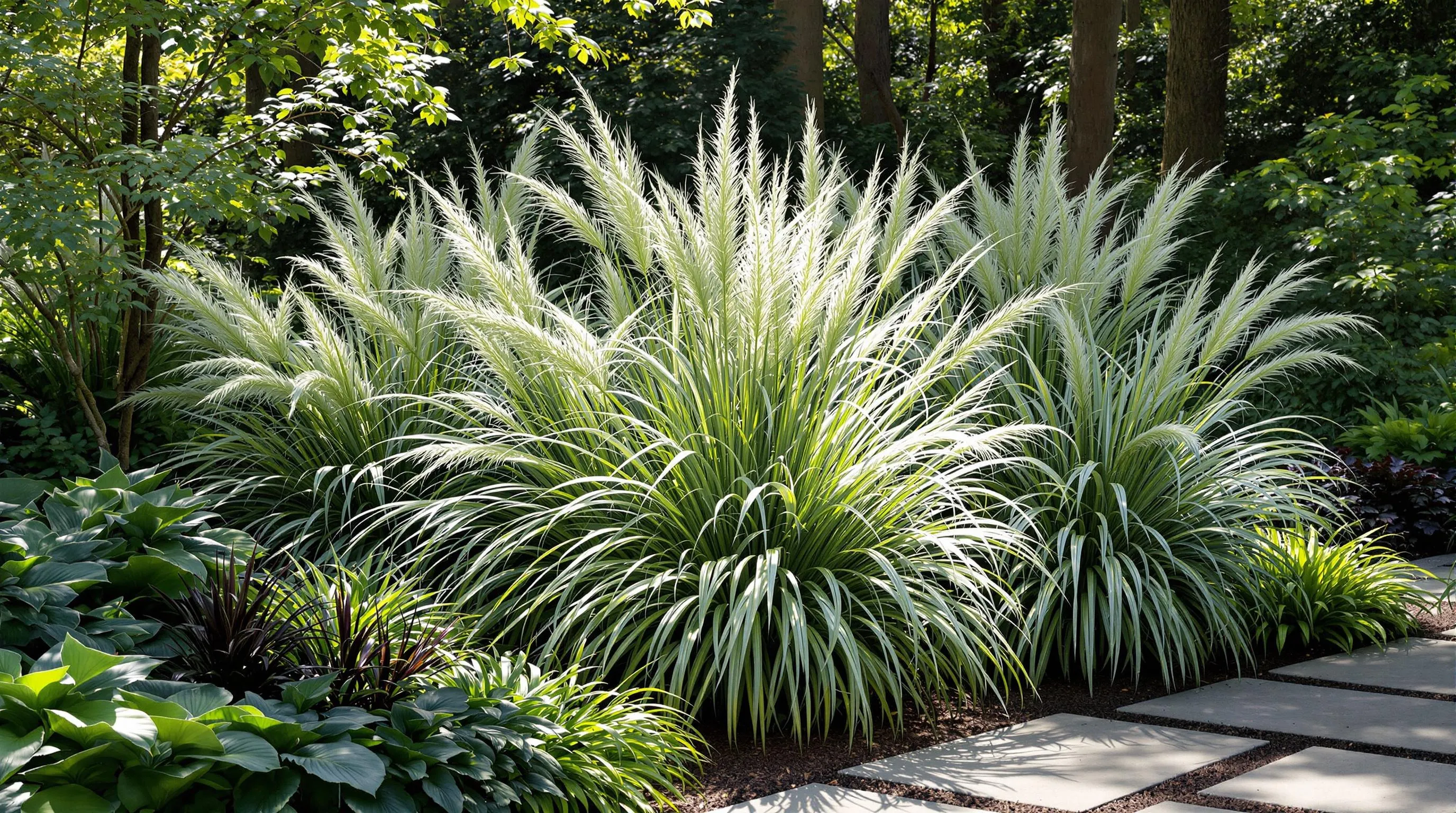
Autumn Moor Grass creates elegant, fine-textured clumps that bring a sophisticated touch to shaded garden areas. This European native stands out for its ability to tolerate partial shade while maintaining its attractive form and distinctive silvery-green foliage.
Cultivation in Partial Shade
Autumn Moor Grass thrives in light to moderate shade conditions, making it an excellent choice for woodland garden edges or areas that receive morning sun and afternoon shade. You’ll find it performs best in well-draining soil with moderate moisture, though it shows impressive drought tolerance once established. This cool-season grass reaches 12-18 inches in height with delicate flower spikes extending slightly higher in late summer. Unlike many ornamental grasses, Sesleria autumnalis maintains its attractive appearance throughout winter, providing year-round structure in your shade garden. For optimal growth, divide established clumps every 3-4 years in early spring to rejuvenate the plant and expand your collection.
Design Applications in the Industry
Autumn Moor Grass serves as an exceptional transitional plant between woodland areas and more formal garden spaces. Its fine texture creates beautiful contrast when paired with broad-leaved shade perennials like hostas, heucheras, and hellebores. You can use it as a graceful edging along shaded pathways or mass several plants together for a flowing ground cover effect. The grass’s bright silvery-green color brightens dark corners and creates visual movement even in still air. For contemporary garden designs, try planting in structured groups of three or five among geometric hardscaping elements. Autumn Moor Grass also works beautifully in containers placed in dappled shade, where its arching form can cascade over edges and create elegant focal points on patios or porches.
Maintenance and Care for Shade-Loving Ornamental Grasses

While shade-loving ornamental grasses are generally low-maintenance, proper care ensures they’ll thrive for years. These resilient plants require exact attention at different times of the year to maintain their beauty and vigor.
Seasonal Pruning Guidelines
Pruning shade-loving ornamental grasses correctly maintains their attractive appearance and promotes healthy growth. Cut back deciduous grasses like Japanese Forest Grass and Northern Sea Oats in late winter or early spring before new growth emerges. Use sharp, clean shears to trim these grasses to about 2-3 inches above ground level. For evergreen varieties such as sedges and Mondo Grass, simply remove damaged or browning foliage rather than cutting them back entirely. Hakone Grass benefits from a light spring trim to remove winter-damaged leaves, allowing fresh growth to emerge unimpeded. Avoid fall pruning for most ornamental grasses as their dried foliage provides winter interest and protects the crown from harsh temperatures. Korean Feather Reed Grass should be pruned in early spring, cutting stems to 4-6 inches above the ground to make way for new plumes.
Dividing and Propagation Tips
Dividing shade-tolerant ornamental grasses every 3-4 years prevents overcrowding and rejuvenates tired plants. Spring is the ideal time to divide most shade grasses, just as new growth begins to emerge. For clumping varieties like Japanese Forest Grass and Tufted Hair Grass, dig up the entire plant and split the root ball into sections using a sharp spade or knife, ensuring each division has healthy roots and several growing points. Spreading types such as Ribbon Grass may need more frequent division to control their vigorous growth habit. Plant divisions promptly at the same depth as the original plant in prepared soil enriched with compost. Water thoroughly after planting and apply a light mulch layer to retain moisture. Black Mondo Grass divides most successfully in early spring, while sedges can be divided nearly any time during the growing season as long as you provide consistent moisture afterward. For Northern Sea Oats, division is not only a propagation method but also helps control its self-seeding tendency.
How to Design with Ornamental Grasses in Shaded Areas
With the right selection of shade-loving ornamental grasses you can transform those challenging dark corners into vibrant garden spaces. These versatile plants offer texture movement and four-season interest while requiring minimal maintenance once established.
Remember to assess your exact shade conditions before selecting varieties and consider combining different grasses for layered effects. Japanese Forest Grass Ripple Grass and Northern Sea Oats create stunning combinations when paired with shade perennials like hostas and ferns.
Don’t be afraid to experiment with these adaptable plants in containers woodland gardens or as accents along pathways. Their resilience and beauty prove that even the shadiest spots in your industry can become ever-changing garden features that you’ll enjoy year after year.





